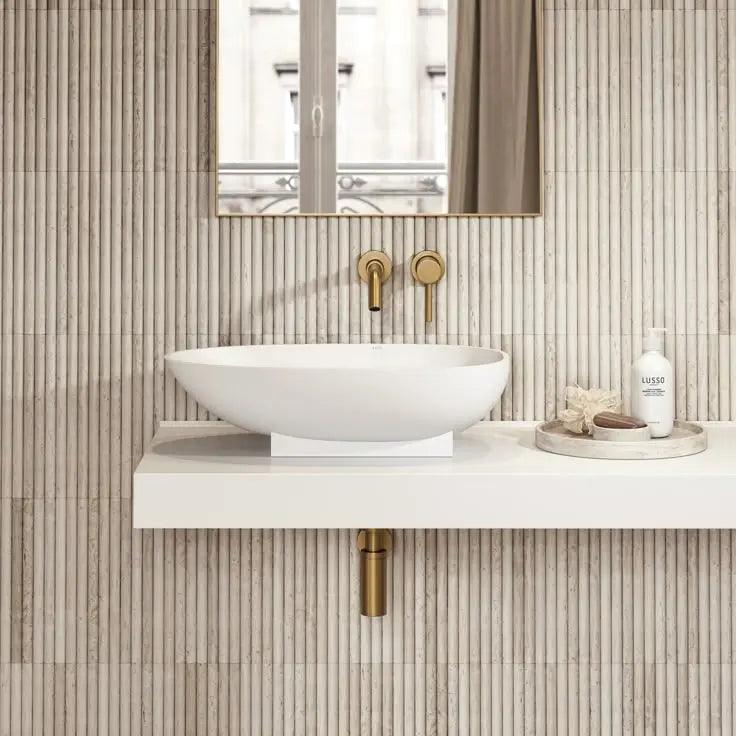Strike a Chord in Design: The Allure of Flute Stone Mosaics
by Shivam Tayal 18 Feb 2025 0 Comments
Introduction to Flute Stone Mosaics
- Flute stone mosaics are an innovative design that combines the beauty of natural stone with the symmetrical geometry of fluted patterns.
- These mosaics are known for their innovative ribbed design, which mimics the shape of organ flutes, and they also create a sense of movement and texture that helps add a layer of depth and sophistication to any area.
- These can be made from a variety of high-quality natural materials, such as marble, granite, travertine, limestone, quartzite, and slate. Due to their three-dimensional design, they bring a fresh appeal to the interior and exterior of the area.
- The flute tiles are laid vertically on the mesh, thus making them ideal to use in areas like statement walls, feature walls, or texture walls, as their versatility allows them to seamlessly integrate with various types of design interiors.
- Due to their unique design, they can play with light and shadow and can cast subtle shadows throughout the day, which creates a dynamic and visual effect on the surface.
- This mosaic can be used anywhere, whether it is a kitchen backsplash, shower wall or feature wall. it will create a point of attraction and elevate the elegance of any area while retaining the natural aesthetic of natural stone
History and Inspiration Behind Flute Patterns
- The concept of these patterns is deeply rooted in ancient architecture, as vertical grooves were commonly used in columns and facades to create a sense of grandeur and luxury.
- In Greek and Roman architecture, these types of designs were very recurring as they added a new dimension and texture to the structure.
- These designs not only enhanced the visual appeal of the area but also created an interplay of light and shadow that accentuated their form.
- In modern times, the fluted pattern was adapted into various types of materials, including natural stone mosaics, which helped the architects to use this historic design to create a sophisticated way to incorporate texture and movement.
- The use of natural stone adds depth and richness to the pattern, with the inherent veining, colour variations, and texture of the stone enhancing the dynamic nature of the design.
- This blend of historical inspiration and modern craftsmanship makes flute stone mosaics a unique and enduring choice for interior and exterior applications.
Application of Flute Stone Mosaic
•
-
Feature Walls and Statement Backdrops
Flute stone mosaics excel at transforming ordinary walls into dramatic focal points. Their ribbed, vertical lines play with light and shadow, offering a visual masterpiece in living rooms, lobbies, and galleries. -
Kitchen Backsplashes
Installed behind stoves or countertops, fluted mosaics create a dynamic yet refined surface. They protect the wall from splashes while serving as an eye-catching design element that complements cabinetry and appliances. -
Bathroom Accents
Ideal for shower enclosures or vanity areas, these vertically grooved stone tiles add both texture and luxury. Pair them with modern fixtures to craft a spa-like ambience in residential or commercial bathrooms. -
Exterior Facades and Columns
Flute stone mosaics bring a sense of grandeur to exteriors, echoing the legacy of Greek and Roman columns. Whether used on architectural pillars or partial facades, they enhance curb appeal with their historic yet contemporary charm. -
Fireplace Surrounds
The rhythmic vertical lines of fluted tiles draw the eye to a fireplace as a natural focal point. The interplay of stone textures and flickering firelight creates a warm, inviting atmosphere in living or dining areas. -
Retail and Hospitality Spaces
Upscale boutiques, hotels, and restaurants benefit from fluted stone’s ability to project sophistication. From reception desks to accent walls, these mosaics set a tone of timeless elegance and refinement.
Installation of Flute Stone Mosaic
- Proper installation of Flute Mosaic is important for longevity and functionality as it requires precision, expertise and attention to detail
- The first step is site preparation, in which the ground is carefully levelled and excavated to create a strong base
- After the stone placement, a high-quality adhesive and mortar mix was applied to secure them into their position
- Then, mosaic tiles, which are usually prearranged on the mesh, are carefully pressed into place, with proper attention given to maintaining consistent spacing and alignment between sheets.
- After that, the space between these sheets is filled with non-staining grout, which acts as a seal to protect from water and also enhances the visual appeal of the area.
- A sealant is applied for outdoor installations to protect the stones from stains, moisture infiltration, and environmental damage, ensuring long-term durability.
Maintenance and Care of Flute Stone Mosaic
- It is very important to properly maintain these marble to preserve their natural beauty and durability.
- This can be done by regularly cleaning of the stone with a ph-neutral stone cleaner and a soft cloth, which would remove dirt and debris without damaging the surface.
- Harsh chemicals should be avoided as they can damage the surface of the stone
- Outdoor installations may require occasional pressure washing to remove dirt and maintain the mosaic’s fresh appearance.




